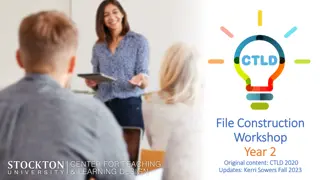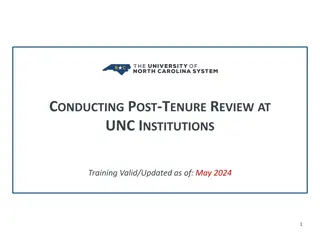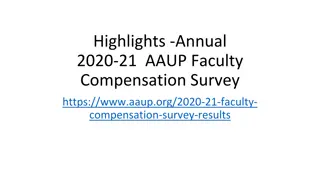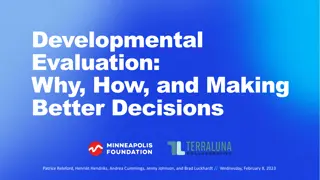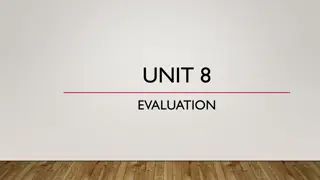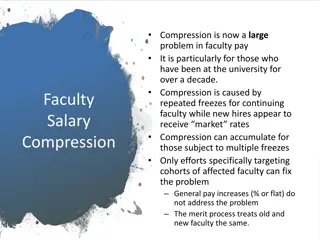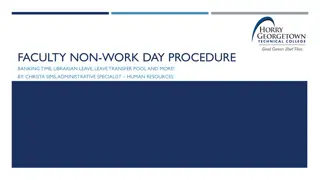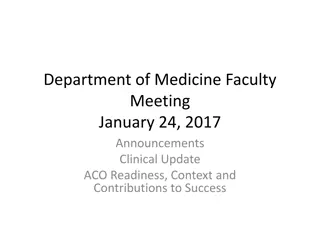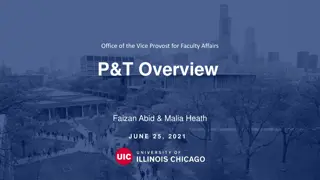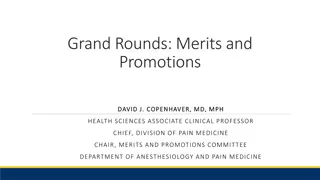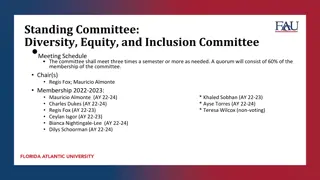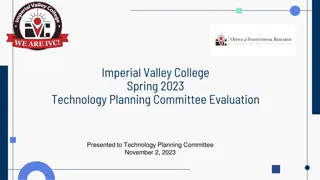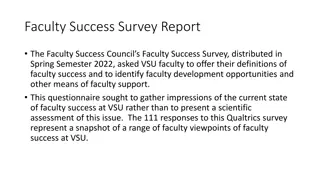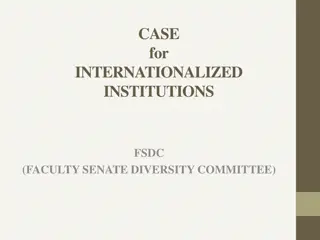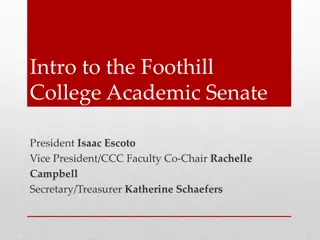Faculty Evaluation Procedures: Committee Structures and Purpose Overview
This slide deck provides information on faculty evaluation procedures, emphasizing the purpose of the evaluation process in supporting faculty development, ensuring student access to quality education, and upholding academic freedom. It also details the committee structures for comprehensive tenured evaluations, covering roles such as the Evaluation Guidance Committee and Division Evaluation Committee.
Download Presentation

Please find below an Image/Link to download the presentation.
The content on the website is provided AS IS for your information and personal use only. It may not be sold, licensed, or shared on other websites without obtaining consent from the author.If you encounter any issues during the download, it is possible that the publisher has removed the file from their server.
You are allowed to download the files provided on this website for personal or commercial use, subject to the condition that they are used lawfully. All files are the property of their respective owners.
The content on the website is provided AS IS for your information and personal use only. It may not be sold, licensed, or shared on other websites without obtaining consent from the author.
E N D
Presentation Transcript
Faculty Evaluation Procedures: What Committee Members, Deans, and Evaluees Need to Know 1
General Reminder All of the information provided in this slide deck is from Appendix G: Evaluation Procedures of the AFT contract Covered are the general procedures that were adopted in September 2014 The AFT website will enable you to confirm the current version of the procedures When in doubt about anything involving evaluation procedures, read Appendix G or ask the Evaluation Guidance Committee It is always appreciated if questions to the Evaluation Guidance Committee come after reading the relevant portion of Appendix G 2
Part 1 - Evaluation Overview: Purpose, Committee Structures and Review Cycles
Purpose of the evaluation process A. The evaluation process should assist faculty in understanding the expectations for employment and tenure; developing skills and acquiring the experience to participate successfully in the educational process; and using the District s and other resources for professional growth. B. The evaluation process should assure that students have access to the most knowledgeable, talented, creative, and student-oriented faculty available. Therefore, periodic performance evaluations are conducted for all tenured, tenure track, and adjunct faculty. A four-year probationary period is provided for tenure- track employees. C. The evaluation process safeguards and assures the principles and practices of academic freedom as defined in District Policies and Procedures. Academic freedom applies equally to all tenured, probationary, adjunct, and grant-funded faculty. D. The evaluation process should assure quality of work performance and professional growth/development by providing a useful assessment of performance.
Committee Structures Tenured For Comprehensive Tenured Evaluations Additional Role Evaluation Guidance Committee Division Evaluation Committee (Tenured Evals.) Evaluee and Dean mutually select evaluator Appropriate Vice President 3-5 tenured faculty (depending on size of division, number of evaluations, diversity of group) Must be tenured faculty District Academic Senate President This is the person who observes classroom, counseling session, etc. Forwarded by division faculty AFT President As faculty participating on a committee, individuals approved by Academic Senate If no mutual agreement on evaluator, then EGC selects evaluator or their designees Senate approval = opportunity for anyone to raise concerns, such as diversity of group Not a committee, so Senate approval not needed for this evaluator role 5
Structure for Adjunct and Grant-Funded Evaluations Evaluation Guidance Committee Evaluator Role Evaluee and Dean mutually select evaluator faculty Appropriate Vice President Must be full-time faculty District Academic Senate President This is the person who observes classroom, counseling session, etc. AFT President If no mutual agreement on evaluator, then EGC selects evaluator or their designees Not a committee, so Senate approval not needed for this evaluator role 6
Committee Structures Tenure-Track As a Committee Evaluation Guidance Committee Tenure Evaluation (Tenure-Track Faculty Evals.) Faculty members are approved by Academic Senate Appropriate Vice President 3 tenured faculty Includes discipline expert District Academic Senate President Senate approval = opportunity for anyone to raise concerns, such as diversity of group Faculty chair agreed on by committee AFT President 1 Dean/Responsible Administrator 2 faculty permanent or their designees 1 faculty position rotates: first evaluator - years 1 and 2 second evaluator - years 3 and 4 7
Review Cycles Tenure-Track and Tenured Evaluations Tenure-track Evaluations Tenured Evaluations Three-year cycle Four-year process Begins three years after tenure-track process completes First tenured evaluation is a comprehensive evaluation Evaluations always occur in the Fall semesters (even if faculty starts in Spring) Three years later is a Standard evaluation Evaluations alternate between Comprehensive and Standard Evaluations every three years But more evaluations occur if tenured faculty doesn t meet or exceed expectations on the overall evaluation. See page 8 of Appendix G, for what happens if there is an Needs Improvement or Unsatisfactory overall evaluation 8
Review Cycles Adjunct and Grant- Funded Evaluations (It s complicated!) First Three Evaluations ( once every two years) Fourth evaluation and after once every three years of employment #1: first semester of employment One year of employment = two fall and/or spring semesters #2: fifth semester of employment Adjunct/Grant-funded faculty only works during summer semesters? Only counting Fall and Spring semesters #1: first semester of employment Two years later if they worked every semester Then once every third summer semester (every two years) #3: ninth semester of employment The above cycles presume the faculty member met or exceeded expectations on the overall evaluation. See pages 23-24 of Appendix G, for process if there is an Needs Improvement or Unsatisfactory overall evaluation 9
Part 2 - Evaluation Ratings: Criteria, The Ratings, Their Meaning, and Evaluator Responsibilities
Evaluation Criteria for Faculty What are evaluators considering? Student Relations Professional Responsibilities Evaluators, Evaluees, and Committee Members should review the complete list of evaluation criteria on pages 3 and 4 of Appendix G. 11
Evaluation Ratings Exceeds Expectations (A): Used for faculty whose performance far exceeds expectations due to exceptionally high quality of work n all essential areas of responsibility, resulting in an overall quality of work that is superior. Meets Expectations (B): Used for faculty who perform assigned responsibilities well, consistently throughout the review period. Needs Improvement (C): should be used for faculty who made a sincere effort to meet the evaluation criteria but need additional guidance to meet them successfully. Unsatisfactory (D): should be used for faculty whose performance was below standard with regard to the evaluation criteria. Steps must be taken to improve overall performance. 12
What do the ratings mean? A. Exceeds Expectations, B. Meets Expectations, C. Needs Improvement, D. Unsatisfactory How do you choose the right one? Each individual committee member will likely have a slightly different understanding of what kind of work merits an A, B, C or D Evaluees should be most concerned with earning passing marks: (B) Meets Expectations. This means that they have what it takes to be a successful faculty member and will receive the next contract. There are no bonus points for getting an A. Evaluators / Committee members should clearly communicate to an evaluee how they view the rating system so that there are no misunderstandings if someone does not get an A . Also, if an evaluee earns a C or D on a specific evaluation item, they will still receive the next contract if they earned B or A for the overall evaluation. 13
Evaluator Responsibilities follow the procedure ! 1. to meet with the evaluee to review criteria and methods of evaluation and the timelines of the evaluation process 2. Discuss the contents of the portfolio and how the contents will be reviewed to gather and review all data obtained by the various evaluation methods employed; 3. to meet with the evaluee to discuss evaluation results and develop a plan for professional growth; 4. to complete Observation, Portfolio Review, and Evaluation Summary forms with commendations and recommendations as appropriate; 5. to determine an evaluation recommendation; and 6. to forward their recommendation to the responsible administrators (or, for tenured comprehensive evaluations, to the chair of the Division Evaluation Committee) 7.
Part 3 - Evaluation Timelines: Adjunct/Grant-Funded, Tenured, and Tenure-Track
Adjunct/Grant Faculty: Timeline Weeks 1-4 of Semester (Fall or Spring) Orientation to All Participants (this is it!) The evaluator meets with evaluee The evaluator establishes a schedule Weeks 5 to 12 of Semester The evaluator completes the Observation(s) (classroom and online) and reports on her/his observations. Student Questionnaires are administered by Week 10. The evaluee completes and submits a Portfolio to her/his division office by Week 11. The evaluee completes and submits the Self-Assessment to the evaluee s division office by Week 11. The evaluator discusses the different evaluation components with the evaluee.
Tenured Faculty: Timeline Weeks 1-4 of Spring Semester Orientation to All Participants (this is it!) The committee meets with evaluee The committee establishes a schedule Weeks 5 to 12 of Spring Semester If a comprehensive evaluation, evaluators complete Observations (classroom and online) and each committee member observes and reports on her/his observations. Student Questionnaires are administered by Week 10. If a Comprehensive evaluation, the individual committee members discuss their classroom observation and provide an overview of the student questionnaires to the evaluee prior to the end of the semester. The tabulated student questionnaires will be made available to the evaluee after grades are posted. If a comprehensive evaluation, the evaluee completes and submits a Portfolio to her/his division office by Week 11. The evaluee completes and submits the Self-Assessment to the evaluee s division office by Week 12.
Tenured Faculty: Timeline contd Weeks 13 17 of Spring Semester If applicable, the Dean/Responsible Administrator completes the Dean/Responsible Administrator s Assessment of Non-Teaching Responsibilities by Week 13. The Committee meets to review the results of the evaluation process and reaches its recommendation. The Committee meets with the evaluee to inform them of the Committee s recommendations and, if the evaluee receives an overall rating of Needs Improvement or Unsatisfactory on the evaluation summary, develops with the evaluee a Performance Improvement Plan. The Evaluation Committee submits its evaluation summary to the appropriate Vice President by Week 17. The Vice President reviews and forwards copies to the evaluee, personnel file, and the Dean/Responsible Administrator. The Dean/Responsible Administrator records the results and schedules the next evaluation.
Tenure-Track Faculty: Timeline Weeks 1-4 of Fall Semester Orientation to All Participants (this is it!) The committee meets with evaluee The committee establishes a schedule Weeks 5 to 12 of Fall Semester Evaluators complete Observations (classroom and online) and each committee member observes and reports on her/his observations. Student Questionnaires are administered by Week 10. Individual committee members discuss their classroom observation and provide an overview of the student questionnaires to the evaluee prior to the end of the semester. The tabulated student questionnaires will be made available to the evaluee after grades are posted. The evaluee completes and submits a Portfolio to her/his division office by Week 11. The evaluee completes and submits the Self-Assessment to the evaluee s division office by Week 12.



